Dal Lake...!!!(information and importance)
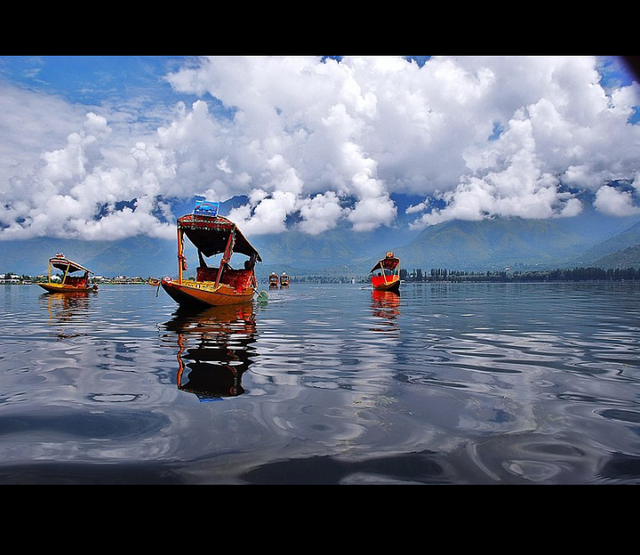
Dal is a lake in Srinagar (Dal Lake is a misnomer as Dal in Kashmiri means lake), the summer capital of Jammu and Kashmir. The urban lake, which is the second largest in the state, is integral to tourism and recreation in Kashmir and is named the "Jewel in the crown of Kashmir" or "Srinagar's Jewel".The lake is also an important source for commercial operations in fishing and water plant harvesting.
The shore line of the lake, is about 15.5 kilometres (9.6 mi), is encompassed by a boulevard lined with Mughal era gardens, parks, houseboats and hotels. Scenic views of the lake can be witnessed from the shore line Mughal gardens, such as Shalimar Bagh and Nishat Bagh built during the reign of Mughal Emperor Jahangir and from houseboats cruising along the lake in the colourful shikaras.During the winter season, the temperature sometimes reaches −11 °C (12 °F), freezing the lake.
The lake covers an area of 18 square kilometres (6.9 sq mi) and is part of a natural wetland which covers 21.1 square kilometres (8.1 sq mi), including its floating gardens. The floating gardens, known as "Rad" in Kashmiri, blossom with lotus flowers during July and August. The wetland is divided by causeways into four basins; Gagribal, Lokut Dal, Bod Dal and Nagin (although Nagin is also considered as an independent lake). Lokut-dal and Bod-dal each have an island in the centre, known as Rup Lank (or Char Chinari) and Sona Lank respectively.
At present, the Dal and its Mughal gardens, Shalimar Bagh and the Nishat Bagh on its periphery are undergoing intensive restoration measures to fully address the serious eutrophication problems experienced by the lake. Massive investments of approximately US$275 million (₹ 11 billion) are being made by the Government of India to restore the lake to its original splendour.
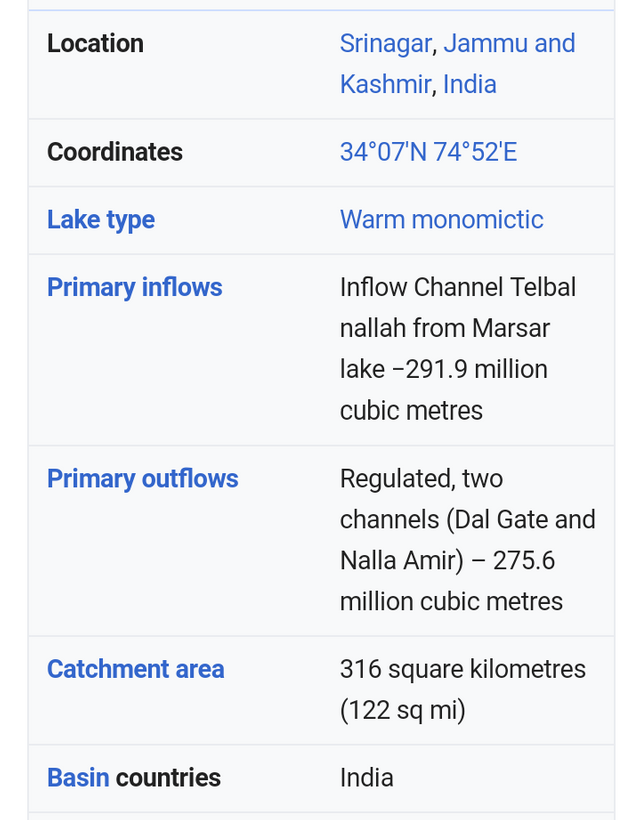
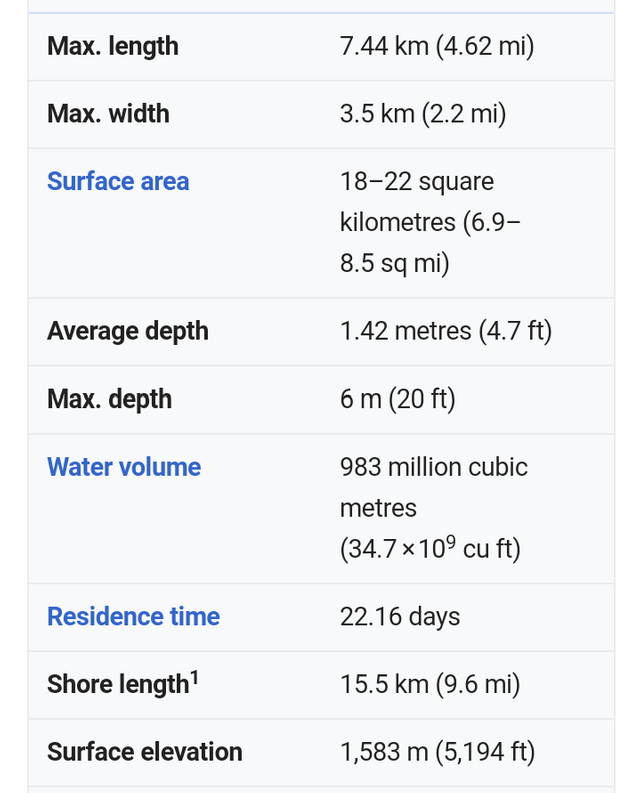
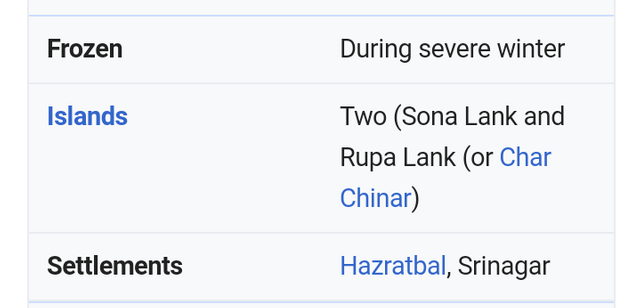
Floura and Fauna:
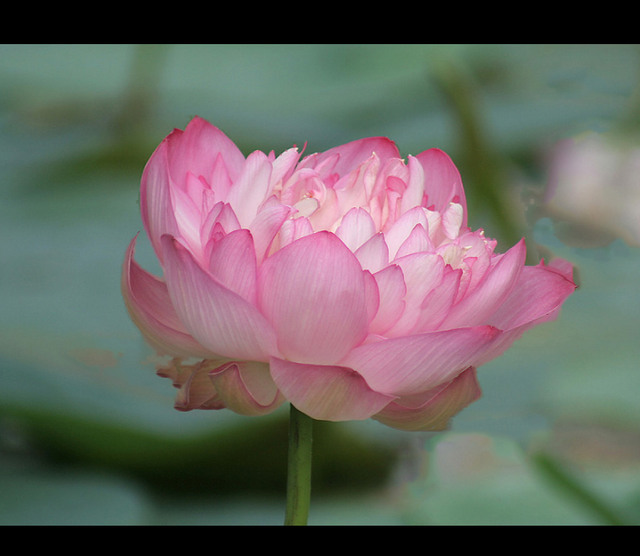
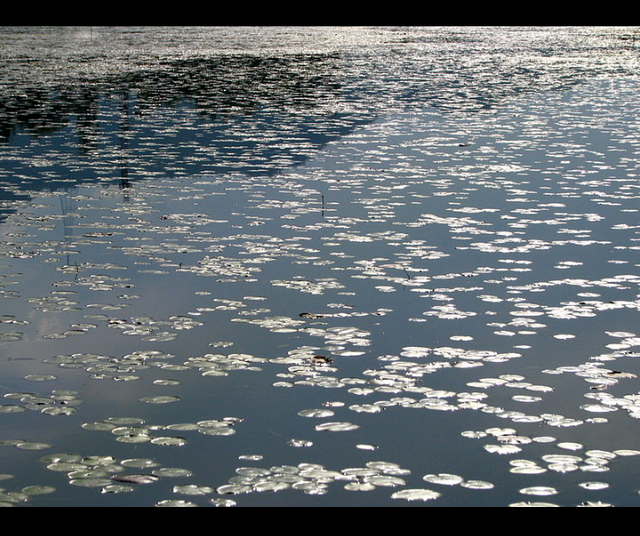
The ecosystem of Dal is ecologically rich in macrophytes, submerged macrophytes, floating macrophytes and phytoplankton.Macrophyte flora recorded in the lake's aquatic and marshland environment consists of 117 species, belonging to 69 genera and 42 families.The lake is noted in particular for its Nelumbo nucifera (lotus flowers) which bloom in July and August. The prolific growth of Ceratophyllum demersum in the eutrophic zones has been reported, with Myriophyllum spicatum and Potemogetton lucens cited as dominant species. Other macrophytes discerned in different zones of the lake include Typho angustata, Phragmites australis, Myriophyllum, Sparganium evectum and Myriophyllum verticillatum, which contribute to the production of macrophites. The rooted variety of the floating leaf type consists of Neelambium nucifera, Nymphaea alba, N.Tertagonia, N.Candida, Nymphoides peltatum, Salvinia natans, Hydrocharis dubia, Nymphaea sp. and Potamogeton natans, all of which occupy 29.2% of the lake.Phytoplanktons include Navicula radiosa, Nitzschia accicularis, Fragilaria crotonensis, Diatoma elongatum, Scenedesmus bijuga, Pediastrum duplex, Tetraedron minimum, Microcystis aeruginosa and Merismopedia elegans.
Since 1934, some important changes have been observed in the lake's biota, including a reduction in the number of Chara species, and an increase in the area covered by Salvinia since 1937. Analysis of the lake has also revealed the tendency for it to develop monospecific communities of submerged macrophytes such as Ceratophyllum and Myriophyllum.
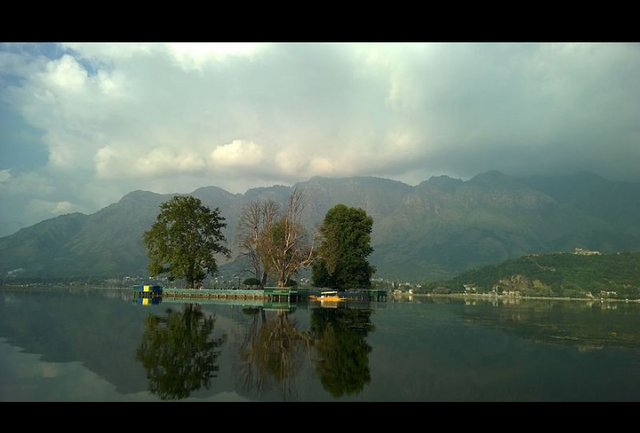
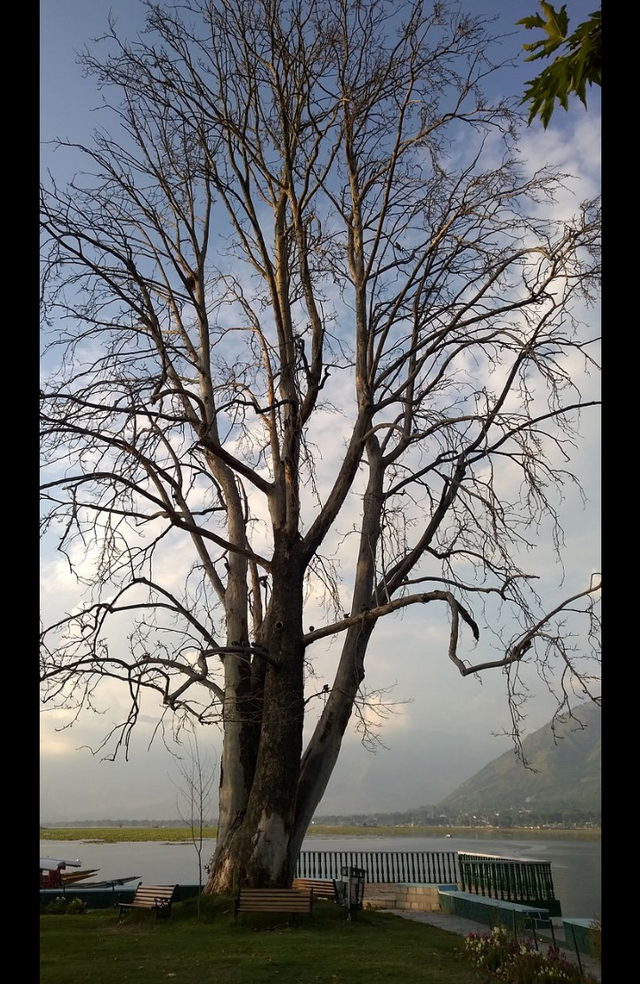
Woody vegetation in the catchment of the lake consists of Melia, Ailanthus, Robinia, Daphne, Celtis, Rose, Ephedra, Pinus roxburghii, Pinus halepensis, Pinus gerardiana, Cupressus torulosa and Cupressus arizonica. The valley also has a rich cultivation of crops such as paddy, wheat and fodder.
Floating gardens, labelled the 'Rad' in tye Kashmiri language are a special feature of the lake. They basically constitute of matted vegetation and earth, but are floating. These are detached from the bottom of the lake and drawn to a suitable place (generally to the north west of the houseboats' location) and anchored. Given its rich nutrient properties, tomatoes, cucumbers and melons are grown with noteworthy results.
The faunal distribution consists of Zooplanktons, Benthos and Fish.Zooplankton found in the lake include Keratella cochlearis, K. serrulata, Polyactis vulgaris, Brachionus plicatilis, Monostyla bulla, Alona monocantha, Cyclops ladakanus and Mesocyclops leukarti. Benthos include Chironomus sp. and Tubifex sp. and fish include Cyprinus carpio specularis (economically important), C. carpio communis, Schizothorax niger, S. esocinus, S. curviformis and Crossochelius latius. It is also reported that Cyprinus, introduced during early sixties, is dominant and that the indigenous species Schizothorax is showing a declining trend.
Fishing resources:
The fishing industry on Dal is the second largest industry in the region and is central to many of the people's livelihoods who reside on the lake's periphery.Dal's commercial fisheries are particularly reliant on carp fish species, which were introduced into the lake in 1957. As a result, carp constitutes 70% of all the fish caught in the lake while the schizothonax constitutes 20% and other species account for 10%. Fishermen use a locally manufactured cast net which comprises six parts with a diameter of 6 metres. It is operated from a wooden fishing boat made out of deodar, typically 20ftx4ft in size. The gradual decline in quality of the lake water through pollution has resulted in lower fish stocks and the extinction of endemic varieties of fish. The causes for such deterioration have been identified and remedial actions have been initiated.The various fishing nets being used in Dal are cast net (Zaal/Duph), Long line (Walruz), Gill net (Pachi, Shaitan zaal), Rod and line (Bislai), Scoop net (Attha zaal) (Bhat et al., 2008).
The lake is warm monomictic (mixing type) and the pH value recorded has varied from a minimum of 7.2 to a maximum of 8.8 on the surface over a yearly period.The Dissolved oxygen [mg l−1] value has varied from a minimum of 1.4 to a maximum of 12.3 on the surface within a year. The Recorded maximum nitrogen concentration (NH4-N [micro l−1] has been recorded as 1315 on the surface and 22 at the bottom of the lake.Phosphorus concentration expressed in Total-P [micro l−1] has varied from a high of 577 to a low of 35 during the 12 months of the year.The lake water temperature has varied from a minimum of 3 °C (37 °F) in January to 26 °C (79 °F) in June at the surface. Transparency, expressed as depth in metres, has varied from a maximum of 1.95 metres (6.4 ft) in July to a minimum of 0.53 metres (1.7 ft) in March, over the 12 months period.
Studies of the water quality of the lake in 1983–84 indicate a decline in quality since the 1965–66 analysis.Scientific research over the years also reveal that Telbal, Botkal, and sewage drains are responsible for a substantial influx of nitrogen and phosphorus into the lake. Quantitatively, fifteen drains and several other sources have released a total of 156.62 tonnes (56.36 tonnes by drains alone) of phosphorus, and 241.18 tonnes of inorganic nitrogen into the lake from a discharge of 11.701 million cubic metres /year.Non-point sources, such as seepage and diffused runoff, also add to this pollution and have been recorded as further adding 4.5 tonnes of total phosphates and 18.
The major environmental problem facing the lake is eutrophication, which has required immediate remedial measures to combat it. Alarmingly, the size of the lake has shrunk from its original area of 22 square kilometres (8.5 sq mi) to the present area of 18 square kilometres (6.9 sq mi), and there is a concerning rate of sediment deposition due to catchment area degradation.The water quality has also deteriorated due to intense pollution caused by the untreated sewage and solid waste that is fed into the lake from the peripheral areas and from the settlements and houseboats. Besides, some experts like Dr. A.A. Kazmi (Associate Professor, IIT Roorkee and in charge of the Environmental Engineering Lab) believe that deforestation in the catchment of Dal and Telbal stream may have led to more nitrogen and phosphorus-rich run-off, further aiding eutrophication. Encroachments of water channels and consequent clogging has diminished the circulation and inflows into the lake, so with the building up of phosphates and nitrogen, this has led to extensive weed growth and consequences on the biodiversity of the lake.
Public interest litigations and restoration works:
Identifying the above major issues as causes for the deterioration of the lake, a multidisciplinary team of experts have prepared a Detailed Project Report (DPR), which has the objective of achieving environment and sustainability, ecological improvement with minimum interventions and displacement and balancing the conflicts of interest. This plan is now under implementation with the financial assistance of the Government of India.
The serious nature of the environmental problems the lake has been experienced has been widely publicised and has been brought to the attention of the Supreme Court of India. Public Interest Litigations (PILs) have been filed in court demonstrating the environmental dangers posed to the lake by sewage, wastes and effluents. The PILs have sought injunctions of the court for setting up of an integrated ring sewage system encircling the Lake; release of funds by the Government of India to undertake measures to check pollution and to inaugurate a High Powered Committee to monitor proper utilisation of the allotted funds. The committee is under obligation to post feedback of progression developments from time to time, directly to the Supreme Court. The PIL, filed in 2001, has resulted in a number of directives from the court to the funding and implementing agencies and the case is continuing. Consequently, under the National Lake Conservation Plan of the Ministry of Environment and Forests of the Government of India, funds to the extent Rs 2987.6 million were sanctioned in September 2005 for the conservation of the lake.The restoration and rehabilitation measures envisaged under the "Conservation and Management of Dal" are under various stages of implementation with the funds allocated by the Government of India for the purpose. Some of the measures undertaken for rehabilitating the lake to bring it to its original eutrophication free status involved measures such as construction of siltation tanks, mechanical deweeding, regrouping of houseboats, deepening of outflow channel and removal of bunds and barricades, including some floating gardens.In addition, a moratorium has been imposed on new construction works close to the lakefront, including the building of new house boats. Resettlement plans for migrating the population from the lakefront have also evolved.The long-term development plans also deal with the reafforestation of catchment area to reduce erosion movement and movement of silt and to regulate grazing by livestock. Recent reports indicate that, as of 2010, 40% of the measures have been implemented.
Uses and attractions:
The lake is popular as a visitor attraction and a summer resort. Fisheries and the harvesting of food and fodder plants are also important on Dal.Weeds from the lake are extracted and converted into compost for the gardens. It also serves as a flood lung of the Jhelum River.[28] Swimming, boating, snow skiing (particularly when the lake is frozen during the severe winter), and canoeing are amongst some of the water sports activities practised on the lake.
The lake has numerous sites and places of interest, many of which are important to the cultural heritage of Srinagar. Aside from the Shalimar Bagh and Nishat Bagh, some of the other places frequented by tourists are the Shankaracharya temple, the Hari Parbat, the Nagin Lake, the Chashme Shahi, the Hazratbal Shrine, and the Mazar-e-Shura cemetery containing the graves of famous Mughal-era poets. Visitors and native alike also enjoy relaxing on the water in a houseboat or a shikara boat, often called "the Gondola of Kashmir".
#Island of Char Chinar
A famous landmark in Srinagar is an island on Dal where four Chinar (Platanus orientalis) trees stand, named "Char Chinar". Char in Hindi and Urdu means four.
#Nagin Lake
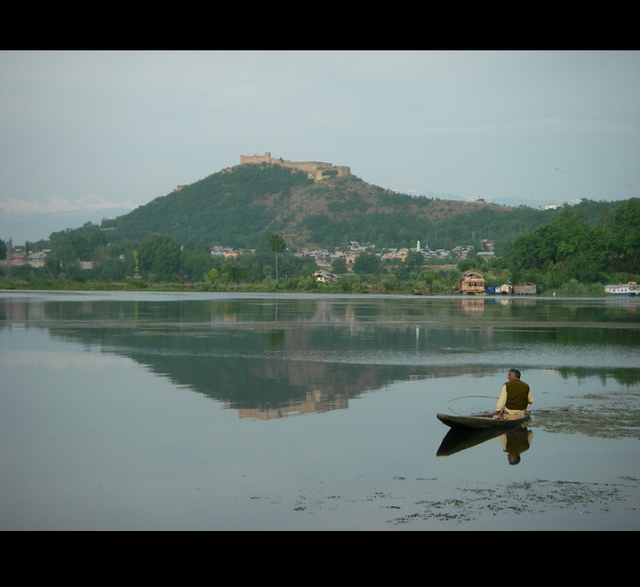
Nagin Lake, though sometimes referred to as a separate lake, is actually part of Dal, being linked through a causeway which permits only bikers and walkers to enter the lake precincts. The caseway carries the water supply pipeline to the Srinagar city in the east. The lake is bounded by the Shankaracharya hill (Takht-e-Suleiman) on the south and Hari Parbat on the west and is located at the foot of the Zabarwan hills. Willow and poplar trees flank the edges of the lake.
#Chashme Shahi
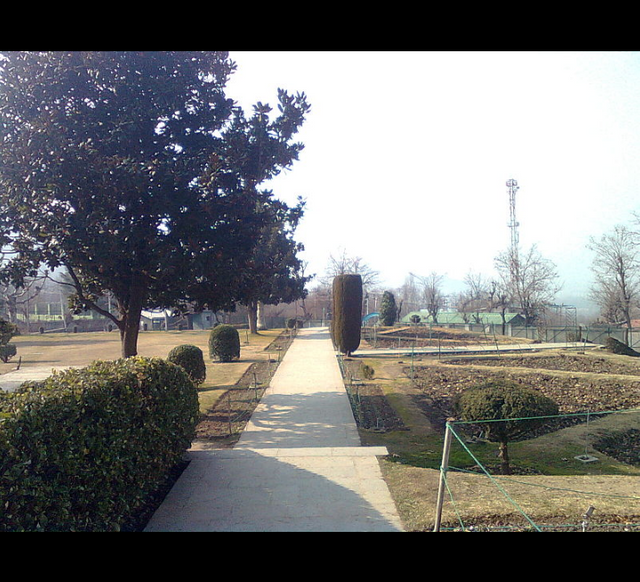
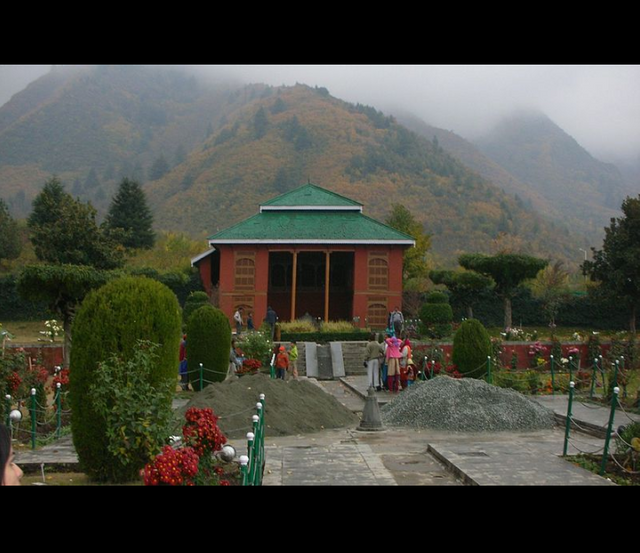
Chashme Shahi, meaning "Royal Spring", is a fresh water spring and garden known for its medicinal properties. Its source located above the Nehru Memorial Park. It is the smallest of all the Mughal gardens in Srinagar, measuring 108 metres (354 ft) x 38 metres (125 ft) and it has three terraces, an aqueduct, waterfalls and fountains.Ali Mardan Khan built the garden in 1632, and is built in such a way that the spring water is the source of fountains. From the fountains, water flows along the floor of the pavilion and cascades to a lower terrace over a drop of 5 metres (16 ft) along a polished black stone chute. A small shrine, known as the Chasma Sahibi, is located in the vicinity of the gardens and has a fresh water spring.
#Shankaracharya Temple
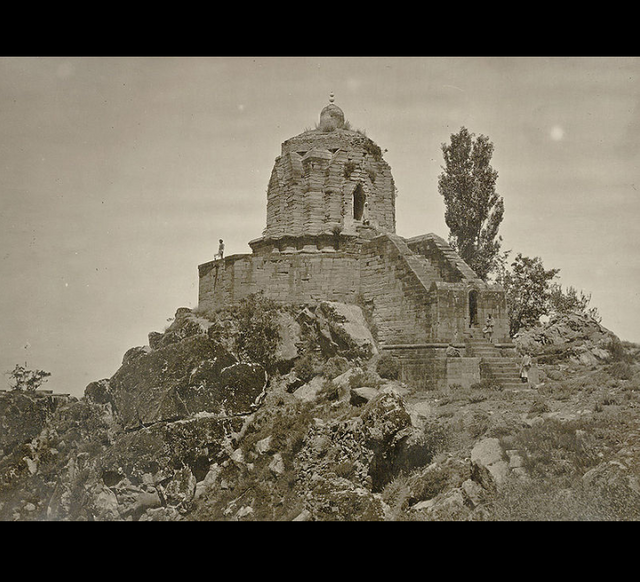
Shankaracharya Temple built in 220 BC. as seen in 1868. Right: Shankaracharya temple as seen now -Overlooks Dal Lake
The sacred Shankaracharya temple, also known as Jyeshteswara, occupies the top of the hills (about 1,000 feet (300 m) above the surrounding Takht-I-Sulaiman plains in the south-east of Srinagar. The site, initially named Gopadri, dates back to 250 BC as a Buddhist monument, probably built by Emperor Ashoka's son Jhaloka. In the 7th century it was replaced by the present temple by King Lalitaditya. The philosopher Shankaracharya is documented as having stayed at this place when he visited Kashmir ten centuries ago to revive Sanātana Dharma.
Built on a high octagonal plinth (20 feet (6.1 m) high) on solid rock and approached by a flight of steps with side walls that once bore inscriptions, the main surviving shrine consists of square building with a circular cell. It overlooks the Srinagar valley and can be approached by car. A modern ceiling covers the inner sanctum and a Persian inscription traces its origin to the reign of Emperor Shah Jahan. There is also a Shiva Linga coiled by a serpent, located in a basin inside the sanctum. The original ceiling was dome-shaped and the current brick roof is said to be about a century old.
#Hari Parbat
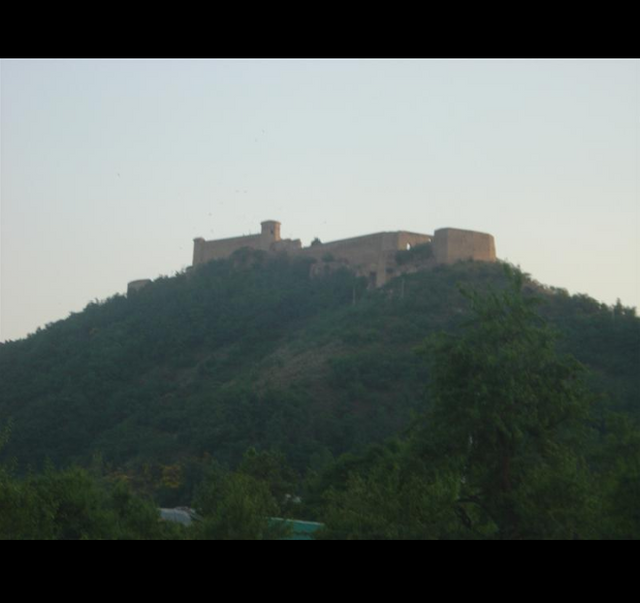
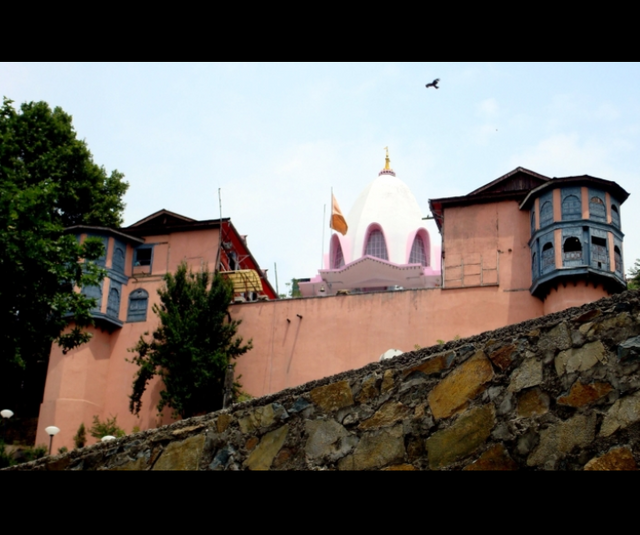
Hari Parbat as seen from Badam Weer (Almond Garden), Srinagar. Right: View of the temple from the stairs
Hari Parbat, also known as the Mughal fort, is a hill fort on Sharika hill that provides panoramic views of the Srinagar city and the Dal. It was first established by Mughal Emperor Akbar in 1590. However, he only erected the outer wall of the fort and his plans to build a new capital called Naga Nagor within it did not materialise. The fort in its current state was built much later in 1808 under the reign of Shuja Shah Durrani. Within the fort's precincts are temples, Muslim shrines, and a Sikh Gurudwara. The hill is the subject of many legends in Hindu mythology, and was said to have once been a large sea, inhabited by a demon known as Jalobhava and that the hill grew from a pebble.
#Hazratbal Shrine
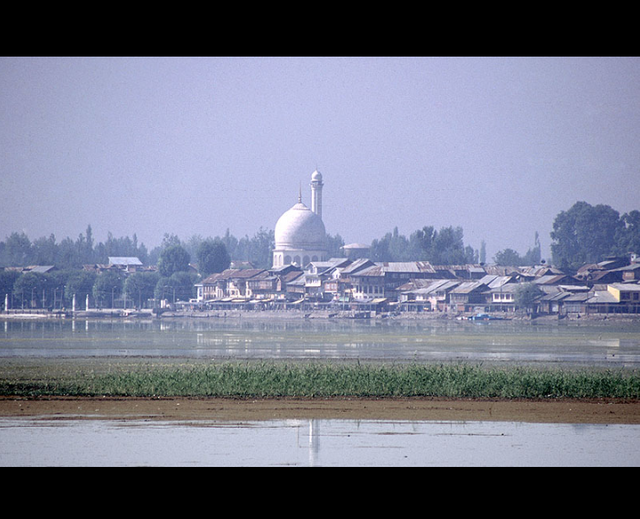
The Hazratbal Shrine (Urdu: حضرت بل, literally: Majestic Place), also named Hazratbal, Assar-e-Sharief, or simply Dargah Sharif,is a Muslim shrine situated on the left bank of the Dal and is considered to be Kashmir's holiest Muslim shrine.It contains a relic believed by many Kashmiri Muslims to be the Moi-e-Muqqadas, a hair from the head of the Islamic prophet Muhammad.According to legend, the relic was first brought to India by Syed Abdullah, a descendant of Muhammad who left Medina and settled in Bijapur, near Hyderabad in 1635. When Syed Abdullah died, his son, Syed Hamid, inherited the relic. Following the Mughal conquest of the region, Syed Hamid was stripped of his family estates. Finding himself unable to care for the relic, he gave it as the most precious gift to his close Mureed and a wealthy Kashmiri businessman, Khwaja Nur-ud-Din Ishbari.
#Mazar-e-Shura Cemetery
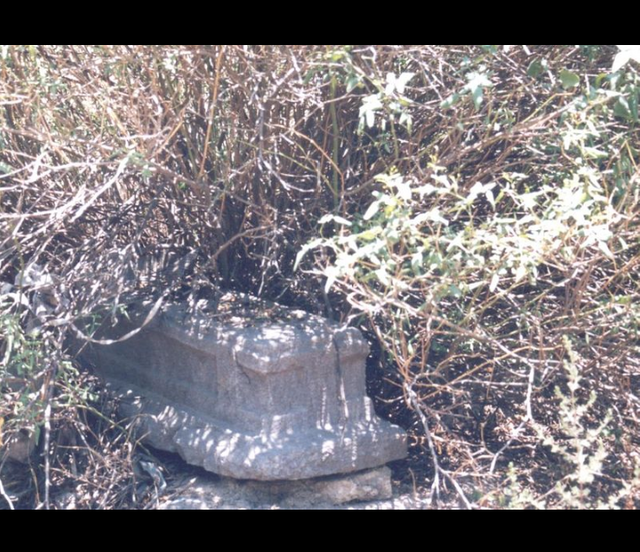
Mazar-e-Shura (Kashmiri: मज़ार-ए-शायरा, Urdu: مزارِ شُعاراء; transliteration: Mazār-i Shuʿārā, translation: The Cemetery of Poets) is a cemetery on a small hill by the main road in Dalgate, an area of Srinagar, Jammu & Kashmir in India. Founded in the reign of the Mughul emperor Akbar the Great, it was built in a scenic location on the banks of the Dal as a cemetery for eminent poets. Historical records show that there were at least five poets and men of letters buried in the cemetery: Shah Abu'l-Fatah, Haji Jan Muhammad Qudsi, Abu Talib Kalim Kashani, Muhammad Quli Salim Tehrani, and Tughra-yi Mashhadi, all natives of Iran who emigrated to India and were associated with the Mughal court. Due to neglect, only three tombstones are currently visible, one of which bears an inscription that is only partially legible.
So we people must try to understand its importance an must be very keen towards its preservation,because it runs the livelyhood of the major population of srinagar...
If you like this post then please upvote it and don't forget to share...
Thankyou@ZAID9